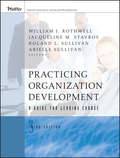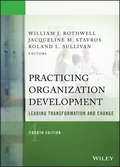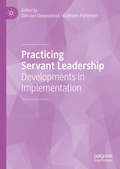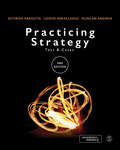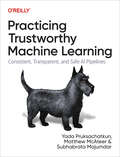- Table View
- List View
Practice of Public Relations
by Sam BlackPublic relations is an essential element in effective and successful business today. The theory of public relations does not change but the practice develops with new ideas and methods of management and business. This fourth edition of 'The Practice of Public Relations' incorporates essential updating and covers new areas such as: *international public relations *crisis management *sponsorship *education and training *career prospects. In 'The Practice of Public Relations' fifteen contributors give well-reasoned, practical introductions to every aspect of public relations. Keys to the many different ways in which public relations can contribute to the achievement of objectives and the successful and harmonious operation of an organization are given thorough coverage. TThis new edition has been prepared to embrace these changes so that CAM students and other readers are fully briefed on the latest issues in the realm of public relations. Sam Black, during his career, has played a significant role in the development of both the Institute of Public Relations and the International Public Relations Association. Contributors: John Cole-Morgan, Betty Dean, Rosemary Graham, Mark D Grundy, Jane Hammond, Brian Harvey, Danny Moss, Margaret Nally, Phyllis Oberman, Michael Regester, Douglas Smith, Tim Travers-Healy, Neville Wade, Sue Wolstenholme.
Practice, Learning and Change
by Alison Lee Ann Reich Paul HagerThe three concepts central to this volume--practice, learning and change--have received very different treatments in the educational literature, an oversight directly confronted here. While learning and change have been extensively theorised, their various contexts articulated and analysed, practice is notably underrepresented. Where much of the literature on learning and change takes the notion of 'practice' as an unexamined given, its co-location as a term with various classifiers, as in 'legal practice' and 'teaching practice', render it curiously devoid of semantic force. In this book, 'practice' is the super-ordinate organising idea. Drawing on what has been termed the 'practice turn in contemporary theory', the work develops a conceptual framework for researching learning in, and on, practice. It challenges received notions of practice, questioning the assumptions, elisions, conflations and silences on the subject. In so doing, it offers fresh insights into learning and change, and how they relate to practice. In tandem with this conceptual work, the book details site-ontological studies of practice and learning in diverse professional and workplace contexts, examining the work of occupations as various as doctors, chefs and orchestral musicians. It demonstrates the value of theorising practice, learning and change, as well as exploring the connections between them amid our evolving social and institutional structures.
Practice-Based Innovation: Insights, Applications and Policy Implications
by Helinä Melkas Vesa HarmaakorpiThe book describes and analyses the new environment for innovation, it does this with an emphasis on yet uncharted regions within the field of practice-based innovation, coming up with guidelines for innovation policy measures needed in order to realise this. While it focuses on these policies it also takes into account multi-actor innovation processes, user-driven innovation, "related variety" and many other aspects; aspects such as, just to name a few: communicating creative processes and distributing practice-based innovation; then there is creativity itself, encompassing new fields of knowledge and expertise. The authors go on to describe value networks, showing how to make practice-based innovations, explaining innovation diffusion and absorptive capacity. The book presents new insights as well as the latest research related to the frequently used term "innovation". Definitions are put forward, giving, by way of examples, a detailed description of concepts we draw upon when using these. Innovation as a concept is constantly being subdivided into increasingly finer distinctions, which, in turn, determine the discourse. The book takes a close look at these, further taking into account the challenges as well as the opportunities inherent in developing practice-based innovation procedures and policies of global importance, never losing sight of advancing long-term effectiveness.
Practice-Focused Research in Further Adult and Vocational Education: Shifting Horizons of Educational Practice, Theory and Research
by Margaret Gregson Patricia SpeddingThis book examines how educational practice can be improved through practice-focused educational research. The editors and contributors explore the issues involved in breaking down boundaries between educational research and practice - research often seen as an elitist activity that can only be determined by a favoured few - as well as the socially constructed nature of boundaries between academic and vocational education. Containing illuminating case studies written by practicing teachers from the further and vocational education sector, it posits that educational research should enable teachers to learn from research in order to improve their own educational practice. This book will be of interest and value to scholars of further and vocational education, as well as those wanting to bridge the gap between research and practice.
Practice-Oriented Marketing: Basics – Instruments – Case Studies
by Ralf T. KreutzerRalf Kreutzer has once again succeeded in setting the right priorities. He makes it convincingly clear that the proven basics in marketing are also valid in the online and digital age. Predict: especially worth reading! Prof. Dr. Dr. h. c. Wolfgang Fritz, Technical University of Braunschweig and University of Vienna The 6th edition has been extensively revised and supplemented with important, current topics of online marketing and digitalization. This further enhances the strengths of the previous editions. Prof. Dr. Klaus Gutknecht, University of Applied Sciences Munich The author encourages critical thinking about the content presented through the use of "mnemonic boxes" and "food for thought". Very good! Prof. Dr. Sabine Haller, Berlin School of Economics and Law An indispensable orientation in the ever faster changing everyday marketing. The book provides implementation and practical know-how without getting lost in details. Univ.-Prof. Dr. Michael Lingenfelder, Philipps-Universität Marburg Further proof of Ralf T. Kreutzer's special expertise in marketing, his great passion for conveying knowledge in the best possible way and his special ability to identify the truly relevant topics. Prof. Dr. Wolfgang Merkle, UE - University of Europe for Applied Sciences, President Marketing Club Hamburg Particularly noteworthy is the expansion of the classic marketing mix to include the fifth P for personnel. Because in the end, it is still the employees who make good marketing! Prof. Dr. Karsten Kilian, Würzburg-Schweinfurt University of Applied Sciences and Markenlexikon.com Concise language, convincing thought leadership, clear examples and goal-oriented transfer questions form an almost ideal basis for opening up the world of marketing. Univ.-Prof. Dr. Klaus-Peter Wiedmann, Leibniz University Hanover New from the 6th edition Newly added are chapters on the topics of the customer journey map, special market research concepts and special forms of static price and condition design. Additional material is available via app: Download the Springer Nature Flashcards app and use exclusive content to test your knowledge.
Practice-Relevant Accrual Accounting for the Public Sector: Producers’ and Users’ Perspectives (Public Sector Financial Management)
by Hassan OudaThis book addresses the necessary developments and adjustments that can be regarded as a promising starting point for making accrual accounting a more practice-relevant for the public sector entities. Specifically, the main focus is on Reshaping the application of accrual accounting principles and assumptions to fit the context of public sector entities; Developing a practice-relevant holistic accounting approach for governmental capital assets, which has been based on developing and reshaping the assets recognition criteria; Scope of general purpose financial reporting from an accountability perspective; Suggesting a sustainable accounting approach for reporting on the long-term fiscal sustainability; Developing a dynamic model for making public sector accrual accounting a more user practice relevant; and finally, Developing a theory of accounting information usefulness, which explains how cognitive aspects do influence the use/non-use of accounting information by the politicians. Fundamentally, the book has tackled these necessary developments and adjustments from both the producer’s and the user’s perspectives.
Practice-based Learning in Higher Education
by Stephen Billett Monica Kennedy Silvia Gherardi Laurie GrealishThis book addresses issues confronting universities' attempts to integrate practice-based learning in higher education curriculum, yet which reveals the jostling of cultures which exist within and amongst the academy, industry, government and professional bodies and other educational providers. The book engages theory in practices, and draws upon research highlighting the issues and transactions that emerge with implementation of work integrated learning arrangements as uses these resources to discuss and develop further both theoretical premises and procedural contributions. The illustrative cases derive utilise metaphors of culture in their exploration of the epistemologies, structures, politics, histories and rituals which constrain program opportunity and success in making these advances. The volume comprises two main sections, the first laying out focal issues in the integration of learning and work in higher education. This section presents the issues at multiple levels of analysis and in theoretical terms. This section provides a foundation for the second section of the book which introduces a number of research studies illustrative of the issues theorised in the first. The cases highlight the practice of workplace and higher education pedagogy. They provide thick descriptions of experiences of integration and are explicitly focused on the implementation of work integrated programs in higher education. The volume commences with an introductory chapter which sets out the range of issues addressed both theoretically and through illustration in the book and a final chapter critically reviews the contributions and acts to provide a cohesive picture of the learning practices of work and higher education and the possibilities of their integration.
Practiceopolis: Stories From The Architectural Profession
by Yasser MegahedThis is a graphic novel about the contemporary architectural profession, in which it acts as the protagonist in the form of an imaginary city called Practiceopolis. The novel narrates quasi-realistic stories that exaggerate the architectural everyday and the tacit, in order to make them prominent and tangible. They depict and dramatise the value conflicts between the different cultures of practising architecture and between the architectural profession and other members of the building industry as political conflicts around the future of Practiceopolis. The book uses the metaphorical world of Practiceopolis to provoke big questions about everyday routines in the profession that practitioners may take for granted and to examine different ideologies at work among architects and other members of the construction industry. The novel ends in the tradition of dystopian worlds common in a certain strand of graphic novels. By vividly illustrating and narrating the critical issues he interrogates, the author has created a world which any architect, student or professional, will both instantly recognise and simultaneously reject, provoking the reader to challenge themselves and the profession at large. <P><P> <i>Advisory: Bookshare has learned that this book offers only partial accessibility. We have kept it in the collection because it is useful for some of our members. Benetech is actively working on projects to improve accessibility issues such as these.</i>
Practices and Perspectives in Sustainable Bioenergy: A Systems Thinking Approach (Green Energy and Technology)
by Madhumi Mitra Abhijit NagchaudhuriThis book presents a systems approach to bioenergy and provides a means to capture the complexity of bioenergy issues, including both direct and indirect impacts across the energy economy. The book addresses critical topics such as systems thinking; sustainability, biomass; feedstocks of importance and relevance (that are not competing with the food market); anaerobic digestion and biogas; biopower and bioheat; and policies, economy, and rights to access to clean energy. This is a contributed volume with each chapter written by relevant experts in the respective fields of research and teaching. Each chapter includes a review with highlights of the key points, critical-thinking questions, and a glossary.This book can be used as a primary or secondary textbook in courses related to bioenergy and bioproducts and sustainable biofuels. It is suitable for advanced undergraduate and graduate students. Researchers, professionals, and policy makers will also be able to use this book for current reference materials.
Practices and Tools for Servitization: Managing Service Transition
by Marko Kohtamäki Tim Baines Rodrigo Rabetino Ali Z. BigdeliThis edited book intends to provide knowledge on tools and practices of servitization to facilitate the formulation and implementation of servitization-based strategies, service infusion and manufacturing service transition globally. Including 22 practically relevant contributions, this book aims to help scholars and practitioners seeking to facilitate servitization in companies through original perspectives and advanced thinking in related issues such as business models, strategic change, practices, processes, routines, value creation and appropriation. Employing practice theory as a useful frame, the contributions span theoretical approaches such as product-service systems, service science, services-dominant logic and cocreation, resource-based views, industrial organization and institutional theory. The book presents tools and frameworks to enable and support servitization and engender understanding of servitization-as-practice.
Practices in Power System Management in India (Power Systems)
by J Raja P Ajay-D-Vimal Raj S RajasekarThis book presents the state-of-the-art methods and procedures necessary for operating a power system. It takes into account the theoretical investigations and practical considerations of the modern electrical power system. It highlights in a systematic way the following sections: Power Sector Scenario in India, Distribution Planning and Optimization, Best practices in Operation & Maintenance of Sub-Transmission & Distribution Lines, Best Practices in Operation and Maintenance of Distribution Substation Equipment’s and Auxiliaries, Best Practice in Operation & Maintenance of Transformer and Protection Systems, International Best Practices in Operation & Maintenance (Advanced Gadgets), Aerial Bunch Conductor (ABC) based Distribution System, Best Practices in Operation & Maintenance of Energy Meters.
Practices in Regional Science and Sustainable Regional Development: Experiences from the Global South
by Soumendu Chatterjee R. B. Singh Mukunda Mishra Andrews José de LucenaThis book brings together the emerging trends and techniques incorporated in regional science during the first two decades of this millennium. The book includes systematic and analytical notes making scientific commentary on the innovative methods of regional development, measurement of the development, regional development models, and policy measures that have significant implications and wide applicability instrumental for India as well as the other global south countries. There is clear evidence in the global south of the uneven spatial distribution of resources, economic activities, literacy, and health conditions. The most striking fact is the coexistence of development and underdevelopment that makes the planning process complicated. This can hardly be explored without taking a deep insight into the matter of how the regional parameters are impacting regional society or economy to shape the development of that region. There can be no effective global policy framework that will be effective equally for each and every region to mitigate local issues of society or economy. It is here that the book integrates the efforts of practitioners working towards addressing these regional issues and striving for sustainable regional development through their innovative ideas.Through its contributions, the book addresses development issues, regional impact of climate change, social justice, migration, well-being, livelihood vulnerabilities, and regional urban-environmental issues from the standpoint of regional science. It is a significant resource for researchers of spatial science, and policy makers.
Practices of Dynamic Collaboration: A Dialogical Approach to Strengthening Collaborative Intelligence in Teams (Management for Professionals)
by Jan De Visch Otto LaskeThis book provides senior managers, project- and program managers, team coaches and team leaders with thought and management tools for potentiating self-organization and creating collaborative intelligence in teams. Adapted and expanded from the 2018 Dynamic Collaboration: Strengthening Self-Organization and Collaborative Intelligence in Teams, the book aids readers in establishing team structures optimal for shared leadership, based on the longitudinal adult development of contributors, especially as team members. Drawing from theoretical and empirical research on social-emotional and cognitive development since 1975, the authors create a provocative paradigm of forming, managing, evaluating and linking teams into networks. They introduce an empirically validated team typology and workspace analysis of dialogue spaces called ‘We-Spaces’. Featuring real world examples and cases of teams that have become self-organizing, this book is a valuable resource for upper and middle level managers, CEOs, Board of Directors as well as consultants, researchers and academics in human resource management, adult development, team building, leadership and organizational management.
Practicing Leadership Principles and Applications
by Arthur Shriberg David ShribergNow business professionals can build a foundation for developing their style of leadership with this fourth edition. New profiles have been added throughout the book that incorporate people, organizations, and nations that have been in the news in the recent past. It also more clearly articulates the connections between the profiles in a chapter and the theory covered. A new chapter explores the latest trends in commonly used workplace technologies and their impact on leadership. It stresses the challenges and opportunities of virtual leadership. Business professionals will also benefit from the inclusion of additional essays by experts in leadership.
Practicing Organization Development
by Sullivan Arielle Rothwell William J. Sullivan Roland L. Stavros Jacqueline M.Completely revised, this new edition of the classic book offers contributions from experts in the field (Warner Burke, David Campbell, Chris Worley, David Jamieson, Kim Cameron, Michael Beer, Edgar Schein, Gibb Dyer, and Margaret Wheatley) and provides a road map through each episode of change facilitation. This updated edition features new chapters on positive change, leadership transformation, sustainability, and globalization. In addition, it includes exhibits, activities, instruments, and case studies, supplemental materials on accompanying Website. This resource is written for OD practitioners, consultants, and scholars.
Practicing Organization Development
by William J. Rothwell Roland L. Sullivan Jackie StavrosGet on the cutting edge of organization development Practicing Organization Development: Leading Transformation and Change, Fourth Edition is your newly revised guide to successful organization development. This edition has been updated to explore the cutting edge of change management, leadership development, organizational transformation, and society benefit. These concepts are explored through emerging and increasingly accepted strengths-based approaches such as: appreciative inquiry, emotionally and socially intelligent leadership, positive organization development, and sustainable enterprises. This edition offers both theoretical concepts and guides to practical applications, providing you with the knowledge, techniques, and tools to put organizational development to effective use in the workplace. Organization development is an evolving field focused on understanding and positively impacting the human system processes of groups, teams, organizations, and individual leaders. Thorough organization development results in increased effectiveness, improved health, and overall success. This book shows how to attain positive change by: identifying contemporary themes in organization development, executing organization development approaches, as well as elevating and extending research agenda. This book also illustrates how to influence organizational stakeholders, and how to use this influence to enact key organization development practices. This new edition is enhanced by: Updated chapter-by-chapter lesson plans, contributor-submitted PowerPoint lesson templates, sample syllabi, and workshop agendas Revised sample exercises, a test bank, and additional case studies Expanded online appendices that cover regional organization development concepts from around the globe, as well as overviews of additional special issues Organization development is quickly becoming an important aspect of MBA curricula. Practicing Organization Development: Leading Transformation and Change, Fourth Edition gives graduate and doctorate program participants a comprehensive overview of organization development, the resources to learn the field, and the tools to apply their knowledge.
Practicing Positive Leadership: Tools and Techniques That Create Extraordinary Results
by Kim CameronPlenty of research has been done on why companies go terribly wrong, but what makes companies go spectacularly right? That’s the question that Kim Cameron asked over a decade ago. Since then, Cameron and his colleagues have uncovered the principles and practices that set extraordinarily effective organizations apart from the merely successful. In his previous book Positive Leadership, Cameron identified four strategies that enable these organizations, and the individuals within them, to flourish: creating a positive climate, positive relationships, positive communication, and positive meaning. Here he lays out specific tactics for implementing them. These are not feel-good nostrums—study after study (some cited in this book) have proven positive leadership delivers breakthrough bottom-line results. Thanks to Cameron’s concise how-to guide, now any organization can be “positively deviant,” achieving outcomes that far surpass the norm.
Practicing Servant Leadership: Developments in Implementation
by Dirk Van Dierendonck Kathleen PattersonBuilding on the original writings of Robert K. Greenleaf, this edited collection provides new insights into servant leadership theory and broadens the conceptual framework with a developmental perspective on modern organisations. Bringing together a group of active servant leadership researchers and practitioners from around the world, this book applies Greenleaf’s original ideas to current challenges within today’s businesses. The authors explore theoretical topics such as purposefulness, compassion, personal growth and mindfulness, as well as providing practical models for implementing a servant leadership culture within organisations, with a particular focus on public administration and the health care industry.
Practicing Servant-Leadership: Succeeding Through Trust, Bravery, and Forgiveness
by Larry C. Spears Michele LawrencePracticing Servant-Leadership brings together a group of exceptional thinkers who offer a compendium of thought on the topic of bringing servant-leadership into the daily lives of leaders. Each contributor focuses on his or her area of expertise, exploring how servant-leadership works in the real world, using examples from a variety of organizations such as businesses, nonprofits, churches, schools, foundations, and leadership organizations. Highlights of the book's twelve essays include information on: how the idealistic vision of the servant as leader works even in the competitive world of business. encouraging leaders to begin by looking at what they themselves want to become and then to bring this knowledge into their daily leadership. how the principles of servant-leadership can enhance our understanding and practice of philanthropy. examining the board chairperson's especially vital role as a servant- leader. exploring what leaders learn from being followers. Order your copy today!
Practicing Strategy
by Loizos Heracleous Duncan Angwin Sotirios Paroutis*Shortlisted for the CMI Management Book of the Year*<P><P> Practicing Strategy is a groundbreaking new textbook focusing on the strategy-as-practice approach, which considers strategy not only as something an organisation has but something which its members do.<P> By bringing together a number of distinctive investigations of strategy practice, this book will enrich your understanding of the dynamic process through which organizational strategies are created and executed.<P> Key features:<P> * The first textbook to be based on insights from the strategy-as-practice perspective, making it an ideal core text for related modules <P> * Packed with real-life mini case studies and a final section containing longer cases from Apple, Centrica, Marconi, Lafarge and Wikimedia, relating theory to practice <P> * Chapters include learning objectives, summaries, discussion questions and further readings and a Companion Website contains additional online readings, to consolidate your learning and encourage in-depth analysis. <P> Practicing strategy is an invaluable text for undergraduate and postgraduate students of advanced strategy modules. <P> Visit the Companion Website at www.sagepub.co.uk/paroutis
Practicing Strategy: Text and cases
by Loizos Heracleous Duncan Angwin Dr Sotirios ParoutisLecturers/Instructors - Request a free digital inspection copy HERE Shortlisted for the 2013 Chartered Management Institute textbook award, Practicing Strategy broke new ground when it first published by focusing on the strategy-as-practice approach, which considers strategy not only as something an organisation has but something which its members do. The new edition deals with a selection of topics that have been central in recent academic debates in the strategy-as-practice area and includes 7 New chapters on topics such as Chief Executive Officers, Middle Managers, Strategic Alignment and Strategic Ambidexterity in line with developments in the field New case studies throughout including Narayana health, the turnaround of Reliant group and relocating a business school Tutor and student access to online resources inlcude additional readings, an Instructor's Manual, PowerPoint slides, author podcasts and videos. Aimed at undergraduate and postgraduate students taking advanced strategy modules and practitioners alike.
Practicing Strategy: Text and cases
by Loizos Heracleous Duncan Angwin Dr Sotirios ParoutisShortlisted for the 2013 Chartered Management Institute textbook award, Practicing Strategy broke new ground when it first published by focusing on the strategy-as-practice approach, which considers strategy not only as something an organisation has but something which its members do. The new edition deals with a selection of topics that have been central in recent academic debates in the strategy-as-practice area and includes 7 New chapters on topics such as Chief Executive Officers, Middle Managers, Strategic Alignment and Strategic Ambidexterity in line with developments in the field New case studies throughout including Narayana health, the turnaround of Reliant group and relocating a business school Tutor and student access to online resources inlcude additional readings, an Instructor's Manual, PowerPoint slides, author podcasts and videos. Aimed at undergraduate and postgraduate students taking advanced strategy modules and practitioners alike.
Practicing Sustainability
by David Green Barbara Oakley Penny Low Guru Madhavan David KoonSustainability applies to everybody. But everybody applies it differently, by defining and shaping it differently--much as water is edged and shaped by its container. It is conceived in absolute terms but underpinned by a great diversity of relatively "green"--and sometimes contradictory--practices that can each make society only more or less sustainable. In Practicing Sustainability, chefs, poets, music directors, evangelical pastors, skyscraper architects, artists, filmmakers, as well as scientific leaders, entrepreneurs, educators, business executives, policy makers, and the contrarians, shed light on our understanding of sustainability and the role that each of us can play. Each contributor addresses what sustainability means, what is most appealing about the concept, and what they would like to change to improve the perception and practice of sustainability. What emerges from their essays is a wide spectrum of views that confirm an important insight: Sustainability is pursued in different ways not only due to different interpretations, but also because of varying incentives, trade-offs, and altruistic motives. Practicing and achieving sustainability starts with a willingness to look critically at the concept. It also means enabling rich and vigorous discussion based on pragmatism and common sense to determine a framework for best ideas and practices. With time and the much needed critical thinking, sustainable development will become a more integral part of our culture. By sharing experiences and crisp insights from today's savants, Practicing Sustainability serves as a stepping stone to the future.
Practicing Trustworthy Machine Learning: Consistent, Transparent, and Fair AI Pipelines
by Yada Pruksachatkun Matthew Mcateer Subho MajumdarWith the increasing use of AI in high-stakes domains such as medicine, law, and defense, organizations spend a lot of time and money to make ML models trustworthy. Many books on the subject offer deep dives into theories and concepts. This guide provides a practical starting point to help development teams produce models that are secure, more robust, less biased, and more explainable.Authors Yada Pruksachatkun, Matthew McAteer, and Subhabrata Majumdar translate best practices in the academic literature for curating datasets and building models into a blueprint for building industry-grade trusted ML systems. With this book, engineers and data scientists will gain a much-needed foundation for releasing trustworthy ML applications into a noisy, messy, and often hostile world.You'll learn:Methods to explain ML models and their outputs to stakeholdersHow to recognize and fix fairness concerns and privacy leaks in an ML pipelineHow to develop ML systems that are robust and secure against malicious attacksImportant systemic considerations, like how to manage trust debt and which ML obstacles require human intervention
Practicing the Necessary Art of Disengagement: When Discovery-Driven Initiatives Must Be Abandoned
by Ian C. Macmillan Rita Gunther McgrathFor all the effort that you may have put into developing each of the discovery-driven plans in your growth portfolio, it's important to remember that even with great planning and strict discipline, many of your projects are unlikely to achieve commercial success. In pursuing a portfolio of growth initiatives, you will find that, sadly, the bulk of them will never emerge as major growth drivers. If redirecting the project doesn't work, you may conclude that rather than let the project continue to sap organizational resources, you need to bite the bullet and shut it down. But how do you make sure that killing an initiative is seen as a constructive process that allows the company to benefit as much as possible from the investments it has made? This chapter tackles this challenge, and discusses the all-important question of how to handle the inevitably disappointed stakeholders and supporters for the project, as well as the politics of the project-termination decision. This chapter is excerpted from "Discovery-Driven Growth: A Breakthrough Process to Reduce Risk and Seize Opportunity."














